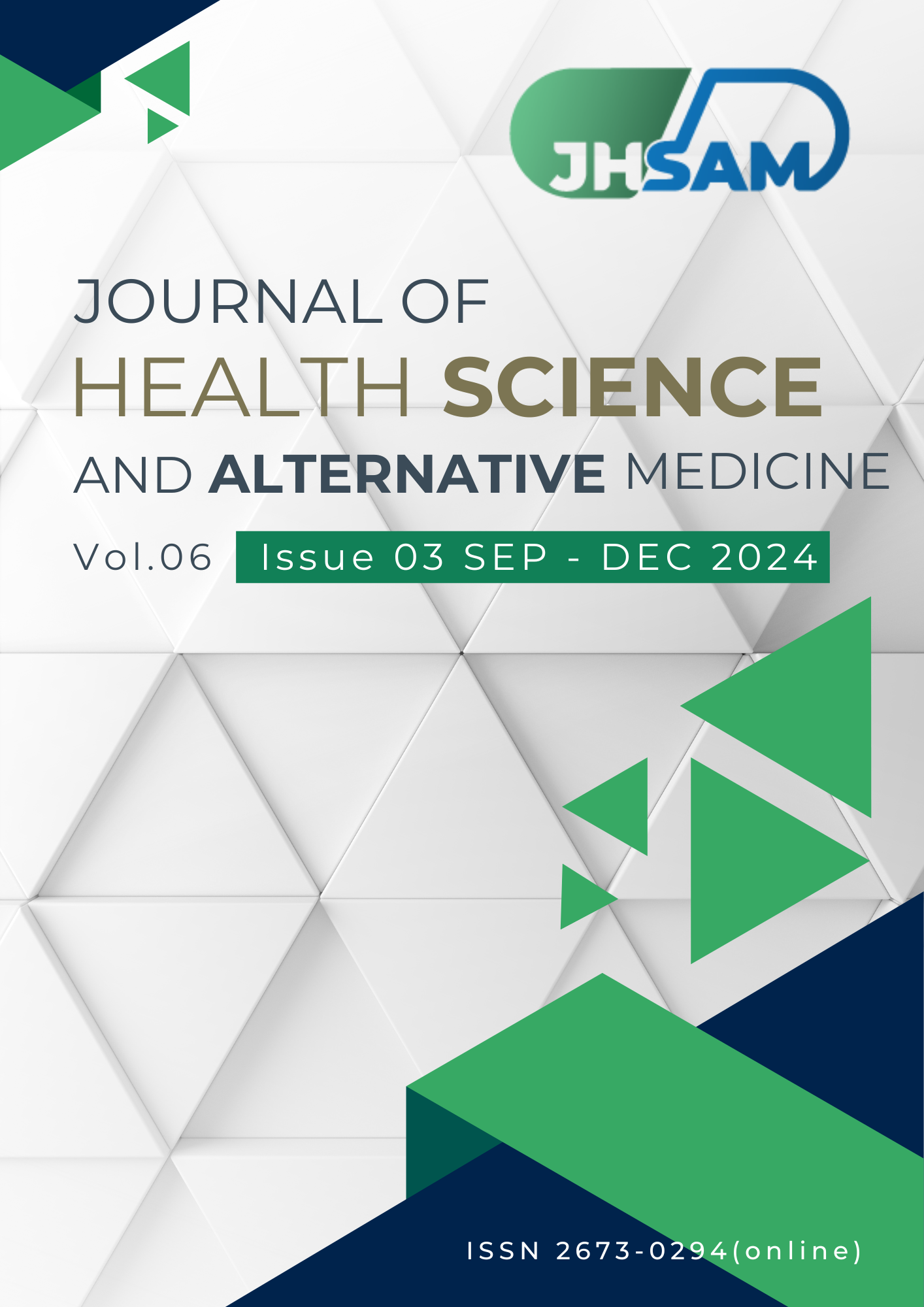Gut Microbiota in Diabetic Kidney Disease in Northern Thailand: A Preliminary Study
Main Article Content
Abstract
Introduction: The risk factors that lead to the development of kidney damage in type 2 diabetic patients were known, such as poor glycemic control and poor blood pressure control. Data on clinical studies from Thailand and many countries show alteration in composition of gut microbiota in diabetes compared with non-diabetes. Studies from certain countries showed alteration in variation and composition of gut microbiota in patients with chronic kidney disease and end-stage kidney disease. There is no information in Thailand on the alteration in variation and composition of gut bacteria in patients with diabetic kidney disease. The main purpose of the study was to compare the difference in diversity and compositions of gut microbiota between three groups of patients: group A, type 2 diabetic patients with diabetic kidney disease (DN); group B, type 2 diabetic patients with normal kidney function (DM); and group C, hypertensive patients with normal kidney function who did not have diabetes (HT).
Methods: After screening and selecting by inclusion and exclusion criteria, 15 type 2 diabetes patients with chronic kidney disease were enrolled as the study participants (group A), 15 type 2 diabetic patients with normal kidney function were enrolled as the controls (group B), and 15 hypertensive patients with normal kidney function were enrolled as another control group (group C). Stool samples were sent for DNA extraction and 16S metagenome sequencing. For bioinformatic analysis, the Alpha-diversity metric, beta-diversity metric, and Principal Coordinate Analysis (PCoA) were applied. Taxonomy was developed for ASVs using the classify-sklearn native Bayes taxonomy classifier against the Greengenes 13_8 99% Operating taxonomy unit (OTUs) reference sequences. Statistical tests of alpha and beta diversity were performed using Kruskal-Wallis and PERMANNOVA.
Results: The study could not demonstrate the difference in community diversity of gut microbiota in all three groups. The Principal co-ordinate analysis (PCoA) based on Bray Curtis dissimilarity at the OTU level is the main method for the beta diversity analysis. PCoA showed no difference in gut microbiota composition among the three groups (p-value 0.544). PCoA using Jaccard, unweighted unifrac, and weighted unifrac distance analysis all of these methods also showed no difference in the microbial composition among the three groups.
Conclusion: The study could not find the differences in diversity and variation in compositions of gut microbiota in comparison among three groups of participants: type 2 diabetes mellitus with diabetic kidney disease, type 2 diabetes mellitus with normal kidney function, and hypertensive patients with normal kidney function. However, this study confirmed the features of gut microbiota compositions in type 2 diabetes mellitus with diabetic kidney disease from many previous studies, for example, the lower ratio of Firmicutes over Bacteroides in the diabetes group compared with the non-diabetes group. In addition, certain factors such as dietary profiles, lifestyle, and ethical investigation of the participants need to be considered in further study.
Article Details

This work is licensed under a Creative Commons Attribution-NonCommercial-NoDerivatives 4.0 International License.
JHSAM publishes all articles in full open access, meaning unlimited use and reuse of articles with appropriate credit to the authors.
All our articles are published under a Creative Commons "CC-BY-NC-ND 4.0". License which permits use, distribution and reproduction in any medium,
provided that the original work is properly cited and is used for noncommercial purposes.
References
Chavasit V, Kriengsinyos W, Photi J, Tontisirin K. Trends of increases in potential risk factors and prevalence rates of diabetes mellitus in Thailand. Eur J Clin Nutr. 2017;71:839-43.
Gruneck L, Kullawong N, Kespechara K, Popluechai S. Gut microbiota of obese and diabetic Thai subjects and interplay with dietary habits and blood profiles. Peer J. 2020;8:e9622.
Sabatino A, Regolisti G, Cosola C, Gesualdo L, Fiaccadori E. Intestinal microbiota in type 2 diabetes and chronic kidney disease. Curr Diab Rep. 2017;17:16.
Tao S, Li L, Li L, Liu Y, Ren Q, Shi M, et al. Understanding the gut-kidney axis among biopsy-proven diabetic nephropathy, type 2 diabetes mellitus and healthy controls: an analysis of the gut microbiota composition. Acta Diabetol. 2019;56:581-92.
Klindworth A, Pruesse E, Schweer T, Peplies J, Quast C, Horn M, et al. Evaluation of general 16S ribosomal RNA gene PCR primers for classical and next-generation sequencing-based diversity studies. Nucleic Acids Res. 2013;41:e1
Bolyen E, Rideout JR, Dillon MR, Bokulich NA, Abnet CC, Al-Ghalith GA, et al. Reproducible, interactive, scalable and extensible microbiome data science using QIIME 2. Nat Biotechnol. 2019;37:852-57.
Segata N, Izard J, Waldron L, Gevers D, Miropolsky L, Garrett WS, et al. Metagenomic biomarker discovery and explanation. Genome Biol. 2011;12:R60
Heberle H, Meirelles GV, da Silva FR, Telles GP, Minghim R. InteractiVenn: a web-based tool for the analysis of sets through Venn diagrams. BMC Bioinformatics. 2015;16:169
Le Chatelier E, Nielsen T, Qin J, Prifti E, Hildebrand F, Falony G, et al. Richness of human gut microbiome correlates with metabolic markers. Nature. 2013;500:541-546.
Yoo JY, Kim SS. Probiotics and prebiotics: present status and future perspectives on metabolic disorders. Nutrients. 2016;8:173.
Eckburg PB, Bik EM, Bernstein CN, Purdom E, Dethlefsen L, Sargent M, et al. Diversity of the human intestinal microbial flora. Science. 2005;308:1635-8.
Stewart CJ, Ajami NJ, O'Brien JL, Hutchinson DS, Smith DP, Wong MC, et al. Temporal development of the gut microbiome in early childhood from the TEDDY study. Nature. 2018;562:583-8.
Doshi SM, Friedman AN. Diagnosis and management of type 2 diabetic kidney disease. Clin J Am Soc Nephrol. 2017 Aug 7; 12(8): 1366-73.
Sang-Ngoen D, Hutchinson C, Satheannoppakao W, Tipayamongkholgul M. Food consumption and accessibility in hill tribe and urban women, Chiang Rai province, northern Thailand. Ecology of Food and Nutrition. 2019;58(4):335-52.
Auntilikun K, Putthong W, Jaitim K, Mongkhonpan K, Saita S, Vittaporn S, et al. Factors affecting food consumption among older adults in a rural community in northern Thailand. American Journal of Health Behavior. 2024 ;48(5):1460-70.


